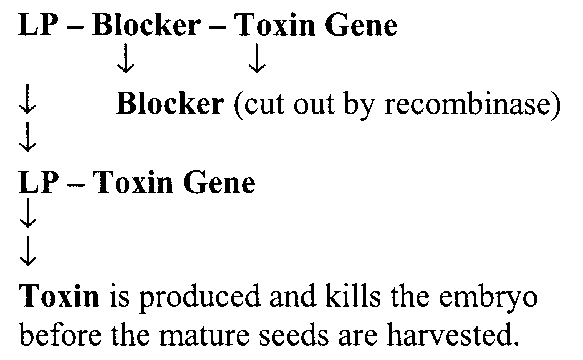
You've reached the Virginia Cooperative Extension Newsletter Archive. These files cover more than ten years of newsletters posted on our old website (through April/May 2009), and are provided for historical purposes only. As such, they may contain out-of-date references and broken links.
To see our latest newsletters and current information, visit our website at http://www.ext.vt.edu/news/.
Newsletter Archive index: http://sites.ext.vt.edu/newsletter-archive/

Terminator Technology for Transgenic Crops
Crop and Soil Environmental News, February 1999
Charles Hagedorn
Professor and Biotechnology Specialist
The "terminator technology" is the biggest--and the most controversial--news in seed research this year. In March, the U.S. Patent Office granted the U.S. Department of Agriculture and Delta and Pine Land Company (DPL) a patent for genetic engineering processes that kill seeds. Described as a "technology protection system" by DPL and as the "terminator technology" by the Rural Advancement Foundation International, the patented processes will be used by seed companies to prevent farmers from saving seeds to plant the following year. The strategy behind the patent is to kill only the embryos--leaving other important seed components such as oils and proteins intact.
How does the terminator technology work?
The technology in the patent could be applied in a number of ways. But in general, it involves three steps:
The technology's success depends on a cleverly controlled sequence of interactions among the spliced-in genes. The last engineered gene comes into play very late in seed development when a special switch under the control of the inducer turns on the gene causing it to produce toxin. The toxin kills the embryo that is part of each mature seed.
An Outline of the Terminator Technology
The terminator technology consists of three genes with their on/off switches. Before selling to farmers, a seed company treats the seeds with a chemical inducer--probably tetracycline--to initiate the terminator gene interactions. Although the patent covers a number of ways the genes might interact, below is a description of one way the technology could work.
| Terminator Genes inthe absence of the Inducer. | Terminator Genes in the presence of the Inducer. | |
Gene I: Repressor | ||
| A repressor gene produces a repressor protein. | The same repressor protein is produced. | |
Gene II: Recombinase | ||
| A recombinase gene is controlled by a promoter. Between the promoter and the recombinase gene, scientists place a DNA fragment which is a binding site for the repressor from Gene I. | ||
| In the absence of the inducer, the repressor binds to the binding site and the plant cannot produce the recombinase protein, an enzyme that snips out pieces of DNA. | The inducer interferes with the repressor attachment to the binding site--thus allowing Gene II to produce recombinase. | |
Gene III: Toxin | ||
| A gene for a toxin lethal to embryos (Toxin Gene) is controlled by a late promoter (LP), that is active only during the late stage of seed development when the embryo is developing. Between the late promoter and the toxin gene, scientists place a piece of DNA called a Blocker, which interferes with the ability of the promoter to turn on the gene. | ||
| Without the inducer, there is no recombinase to snip out the blocker.
With the blocker in place, no toxin is produced. |
Recombinase from Gene II snips out the blocker and allows the late promoter to turn on production of the toxin gene late in the season. | |
| Thus, by withholding the inducer, seed companies can produce generations of viable seeds. |  |
|
Terminator Technology and the Developing World
The terminator technology has similar, but even more troubling, implications for the developing world where seed saving is more widely practiced than in the U.S. Poor farmers are especially alarmed at the prospect of seed markets dominated by multinational corporations selling sterile seeds. They fear increased seed costs and loss of control over their own food supplies. What poor farmers need is inexpensive, locally adapted seed that can be easily saved, not sterile seeds that must be repurchased every year.
In India, for example, concern about the terminator technology and other applications of genetic engineering led farmers to uproot and burn genetically engineered Bt cotton. The intensity of the reaction is based partially on the misconception that the terminator is already in commercial crops. Although its implementation is still some years away, the reaction is an indication of the likely response to the terminator when it is ready.
Concerns about the impact the terminator will have on poor farmers have also led the United Nations-funded Consultative Group on International Agricultural Research to recommend that its sixteen member institutes ban the technology in their crop improvement research programs. For more information about the impacts of terminator technology on global food security and developing-country agriculture, see the Rural Advancement Foundation International website at:
Sources
Times of London, November 4, 1998; and Times of India, December 4, 1998.
M.J. Oliver et al., "Control of plant gene expression," US Patent Number 5,723,765, March 3, 1998.
M.L. Crouch, "How the Terminator terminates: an explanation for the non-scientist of a remarkable patent for killing second generation seeds of crop plants." The Edmonds Institute, Edmonds, Wash., 1998.
Union of Concerned Scientists. "Biobit and Terminator Technology." The Gene Exchange, Winter 1998. pp. 4-5.